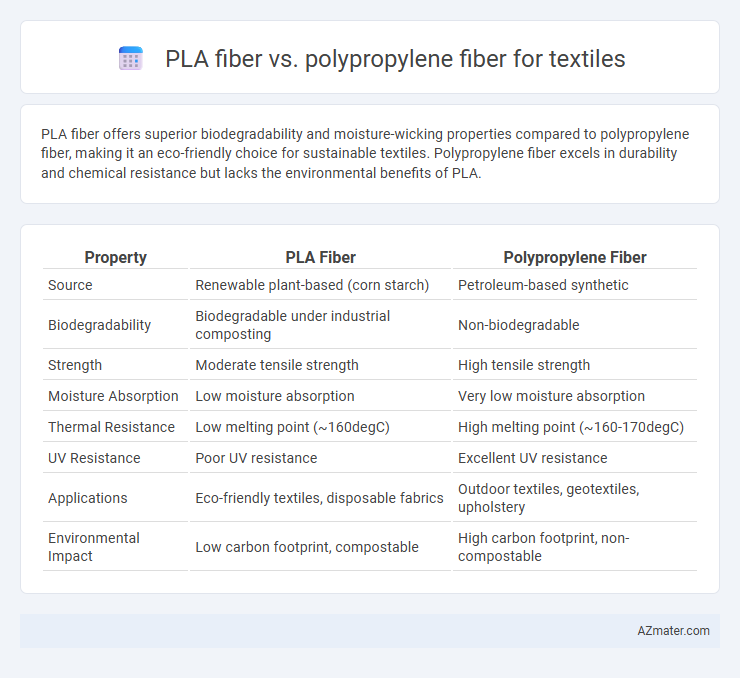PLA fiber offers superior biodegradability and moisture-wicking properties compared to polypropylene fiber, making it an eco-friendly choice for sustainable textiles. Polypropylene fiber excels in durability and chemical resistance but lacks the environmental benefits of PLA.
Table of Comparison
| Property | PLA Fiber | Polypropylene Fiber |
|---|---|---|
| Source | Renewable plant-based (corn starch) | Petroleum-based synthetic |
| Biodegradability | Biodegradable under industrial composting | Non-biodegradable |
| Strength | Moderate tensile strength | High tensile strength |
| Moisture Absorption | Low moisture absorption | Very low moisture absorption |
| Thermal Resistance | Low melting point (~160degC) | High melting point (~160-170degC) |
| UV Resistance | Poor UV resistance | Excellent UV resistance |
| Applications | Eco-friendly textiles, disposable fabrics | Outdoor textiles, geotextiles, upholstery |
| Environmental Impact | Low carbon footprint, compostable | High carbon footprint, non-compostable |
Introduction to PLA and Polypropylene Fibers
PLA fiber, derived from renewable resources like corn starch, is a biodegradable and eco-friendly textile material gaining popularity for sustainable fashion. Polypropylene fiber, a synthetic polymer made from petrochemicals, is valued for its lightweight, moisture-wicking properties, and durability in activewear and industrial textiles. Both fibers offer unique advantages, with PLA emphasizing environmental benefits and polypropylene focusing on performance and cost-efficiency.
Chemical Structure and Composition
PLA fiber, derived from polylactic acid, is a biodegradable polyester synthesized from renewable resources like corn starch, featuring ester linkages that promote hydrolytic degradation. Polypropylene fiber is a synthetic polyolefin composed of repeating propylene monomers forming a non-polar hydrocarbon chain, characterized by high chemical resistance and hydrophobicity. The chemical composition of PLA offers enhanced biodegradability, while polypropylene's structure provides superior chemical inertness and durability in textile applications.
Production Process Comparison
PLA fiber is produced from renewable resources like corn starch through a fermentation process, followed by polymerization and spinning, which results in biodegradable and eco-friendly textile fibers. Polypropylene fiber is synthesized via a chemical polymerization of propylene monomers using a high-temperature, catalyst-driven process, yielding a hydrophobic and chemically resistant textile fiber. The PLA production relies on bio-based raw materials with slower processing times, while polypropylene utilizes petrochemical feedstocks enabling faster, large-scale manufacturing.
Mechanical Properties and Durability
PLA fiber exhibits superior tensile strength and stiffness compared to polypropylene fiber, making it suitable for applications requiring enhanced mechanical performance. Polypropylene fiber provides excellent impact resistance and elongation, contributing to its durability in dynamic conditions and wear-intensive uses. While PLA fiber has moderate biodegradability, its mechanical durability can be lower under prolonged exposure to moisture and UV light compared to the inherently chemical-resistant and moisture-resistant polypropylene fiber.
Comfort and Breathability in Textiles
PLA fiber offers superior moisture-wicking properties and enhanced breathability compared to polypropylene fiber, making it ideal for comfortable textile applications. Its natural origin provides a softer hand feel and better thermal regulation, reducing heat retention during wear. Polypropylene fiber, while hydrophobic and quick-drying, tends to trap heat and offers less breathability, which can compromise wearer comfort in textiles.
Environmental Impact and Sustainability
PLA fiber, derived from renewable resources like corn starch, offers significant environmental benefits through biodegradability and reduced carbon footprint compared to petroleum-based polypropylene fiber. Polypropylene fiber, while durable and cost-effective, is non-biodegradable and contributes to microplastic pollution, raising concerns over long-term environmental impact. The sustainability of PLA fiber is enhanced by its compostability and lower energy consumption in production, making it a preferable choice for eco-conscious textile applications.
Biodegradability and Recycling Potential
PLA fiber, derived from renewable resources like cornstarch, offers excellent biodegradability under industrial composting conditions, breaking down into water and carbon dioxide within months. Polypropylene fiber, a petroleum-based synthetic material, exhibits poor biodegradability and can persist in the environment for hundreds of years, posing significant microplastic pollution risks. Recycling PLA fibers remains limited due to contamination and processing challenges, while polypropylene benefits from established mechanical recycling streams but struggles with degradation of fiber quality after multiple cycles.
Cost Analysis and Market Availability
PLA fiber typically incurs higher production costs than polypropylene fiber due to its bio-based raw materials and energy-intensive manufacturing processes, impacting overall textile pricing. Polypropylene fiber benefits from widespread availability and cost-effective production from petroleum derivatives, resulting in lower market prices and greater accessibility for large-scale textile applications. Market trends indicate increasing demand for PLA fiber in sustainable textiles, yet polypropylene remains dominant in cost-sensitive sectors due to its affordability and extensive supply chain.
Applications in the Textile Industry
PLA fiber offers superior biodegradability and moisture-wicking properties, making it ideal for sustainable fashion and activewear applications in the textile industry. Polypropylene fiber excels in durability, chemical resistance, and moisture management, commonly used in industrial textiles, geotextiles, and technical sportswear. Both fibers cater to specific market demands, with PLA prioritizing eco-friendly textiles and polypropylene focusing on performance-driven uses.
Future Trends and Innovations
PLA fiber exhibits growing popularity in textiles due to its biodegradability and renewable sources, aligning with increasing consumer demand for sustainable fabrics. Innovations in PLA fiber production focus on enhancing mechanical strength and moisture management to rival traditional polypropylene fibers, which are valued for durability and cost-effectiveness in textile manufacturing. Future trends indicate a convergence where hybrid fibers combining PLA and polypropylene properties emerge, optimizing environmental impact without compromising performance.

Infographic: PLA fiber vs Polypropylene fiber for Textile
 azmater.com
azmater.com